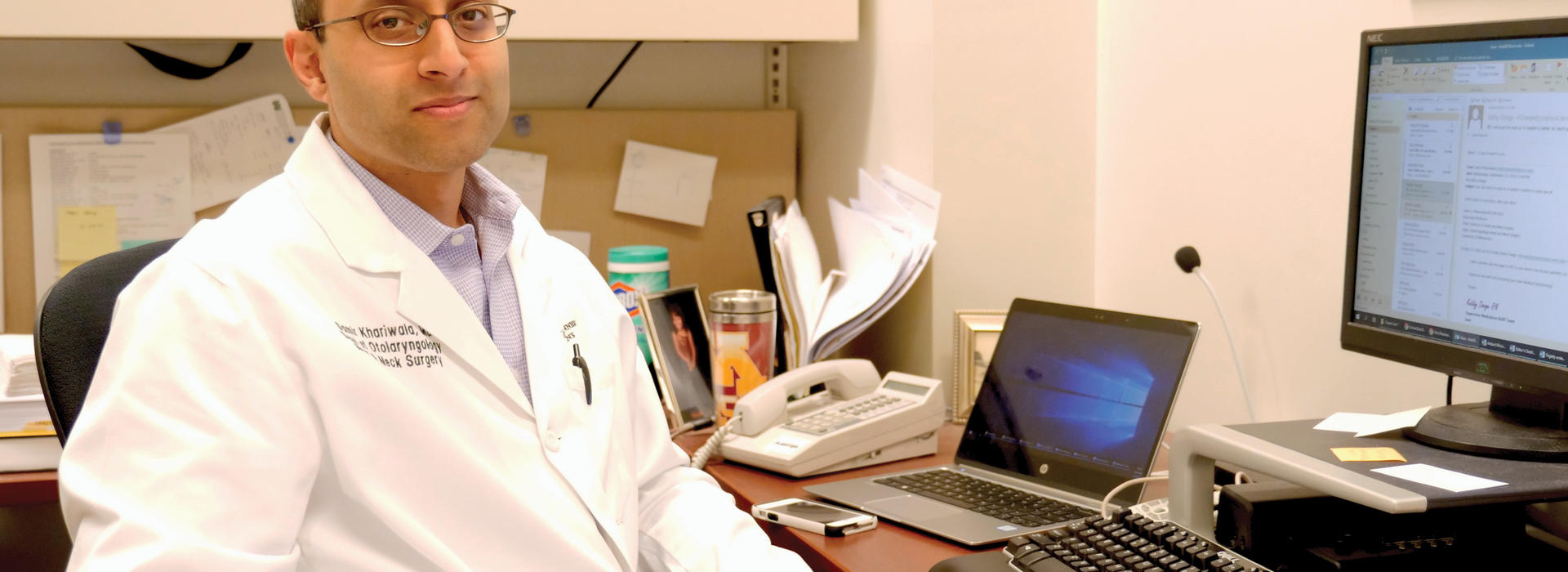
Faculty Spotlight: Dr. Samir Khariwala
“This was my first job after fellowship and I’ve been here ever since.”
Dr. Samir Khariwala is an Associate Professor and Chief of the Division of Head and Neck Surgery in the Department of Otolaryngology-Head and Neck Surgery. Originally from Michigan, Dr. Khariwala attended medical school at the University of Pennsylvania before coming to Minnesota to focus on his research in addition to the clinical care of patients with head and neck cancer.
Specializing in tobacco-related research, Dr. Khariwala looks specifically at tobacco products and their link with oral cancer. “My research is related to understanding how tobacco causes oral/ head and neck cancer. Obviously, smoking causes cancer, but we are trying to understand what parts of tobacco are most dangerous and who is the most at risk for developing tobacco-induced cancer.”
Otolaryngology is a diverse field that has many different areas of specialization. Dr. Khariwala spends all of his time as a head and neck surgical oncologist. “All the patients that come to see me are at a vulnerable point,” Khariwala states. “We have the chance to make a big difference in their ability to survive their disease, as well as their ability to maintain their quality of life.”
Job satisfaction comes to Dr. Khariwala from the ability to help each patient at a critical point in their lives. “Even in the worst cases, if you can’t cure them, you’re still an integral part of their management; the understanding of their disease, planning, providing treatment and helping them understand what’s going to come next.”
RO1 Award Recipient
In 2018, Dr. Khariwala, along with his colleague Dr. Irina Stepanov, PhD, was awarded an RO1 grant to study smokeless tobacco products in India and how these products contribute to an epidemic of oral cancer in India. “It’s an international project. India has a significant oral cancer problem which is primarily due to rampant use of smokeless tobacco products.”
The RO1 grant provides support for health-related research and development based on the mission of the National Institutes of Health (NIH). NIH’s mission is to seek fundamental knowledge about the nature and behavior of living systems and the application of that knowledge to enhance health, lengthen life, and reduce illness and disability.
The diverse array of smokeless products in India makes it very difficult to monitor what is going into these products. Some are coming from industrial companies, while some are coming from local street vendors.
The grant will be used to classify smokeless tobacco products and understand the variability in carcinogen levels between them. “The data’s just not out there about what is in these products,” explains Dr. Khariwala. “The other part of it is trying to link the levels of carcinogens that we’re seeing in products to the development of oral cancer in people that are using them [smokeless tobacco products].”
Dr. Khariwala is collaborating with an institution in Mumbai, India, Tata Memorial Center. This is one of the largest cancer facilities in Asia, which allows them to see a high volume of patients.
Part of the grant is being used to bring over trainees from the Tata Memorial Center to the University of Minnesota Medical School to be able to train them in on how to conduct this research. Currently, in year two of a five-year project, Dr. Khariwala’s team will soon begin recruiting subjects.
“If we accomplish our goals, we will have cataloged a series of smokeless tobacco products in India based on what they’re made up of and what their carcinogen levels are,” explains Dr. Khariwala. “The other part would be to link the levels of carcinogens in those products to what we see in users.”
The end goal that Dr. Khariwala has in mind is two-fold. The first is to present this information to the Indian government in hopes of passing legislation related to tobacco regulation. “We hope to see them either ban certain or all products or ban certain levels of carcinogens in products,” says Dr. Khariwala.
The second part of this goal is to educate the people in India about their results. “Part of the problem is that smokeless tobacco is ingrained in the culture and education about the products is lacking, a lot of people don’t know that what they’re doing is dangerous.”
The Future of Head and Neck Surgery
Most of Dr. Khariwala’s goals for his division lie in expanding and growing both in numbers and technological advancement.
“We want to continue to grow our group of head and neck cancer providers so we can continue to service the population of Minnesota.” Dr. Khariwala explains how he hopes to expand service from the metropolitan area to further regions closer to bordering states.
Another area to focus on is incorporating more research into the busy lives of head and neck surgeons. “Sometimes it can be difficult to carve that time out to do research on top of patient care.”
When looking to the future of the next generation of medical providers, Dr. Khariwala would encourage current medical students to follow their interests and consider a career in oncology. “It’s a life well lived if you are spending it saving lives.”